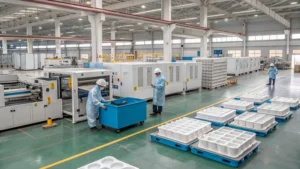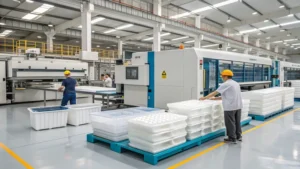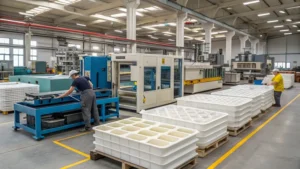
Vacuum forming is a versatile manufacturing process that shapes heated plastic sheets using vacuum pressure to create lightweight, large-scale products efficiently. However, the raw parts often require additional surface finishing to meet aesthetic and functional demands. This article explores advanced surface finishing techniques1 for vacuum-formed products, delving into their definitions, applications, pros and cons, technical details, and practical tools to enhance your manufacturing process.
Vacuum forming shapes heated plastic sheets over molds using vacuum pressure, with advanced surface finishing2 techniques enhancing durability, aesthetics, and functionality across industries like automotive, packaging, and medical.
Understanding these techniques can optimize your vacuum-formed products for specific needs, from improving durability to enhancing visual appeal. Read on to discover how finishing methods and material choices impact performance.
Surface finishing is essential for all vacuum-formed products.False
While beneficial for many applications, some products may not require finishing depending on their functional or aesthetic requirements.
Vacuum forming is only suitable for low-volume production.False
It excels in low-to-medium volumes but can be adapted for larger runs with proper tooling and process optimization.
- 1. What are the Common Surface Finishing Techniques for Vacuum Formed Products?
- 2. What are the Steps in the Vacuum Forming and Finishing Process?
- 3. What are the Key Factors in Selecting Surface Finishing Techniques?
- 4. What are the Applications of Advanced Surface Finishing in Vacuum Formed Products?
- 5. What are the Differences Between Vacuum Forming and Injection Molding in Terms of Finishing?
- 6. Conclusion
What are the Common Surface Finishing Techniques for Vacuum Formed Products?
Surface finishing3 enhances the quality of vacuum-formed parts, making them suitable for diverse applications by improving appearance, durability, and functionality.

Common techniques include trimming, smoothing, coating, texturing, and decorating, each tailored to specific industry needs like automotive, packaging, and consumer goods.
| Technique | Method | Applications |
|---|---|---|
| Trimming | Guillotining, CNC machining | Automotive, packaging |
| Smoothing | Sanding, polishing | Consumer goods, medical |
| Coating | Spray, roller coating | Automotive, consumer goods |
| Texturing | Excimer matting, embossing | Packaging, consumer goods |
| Decorating | Digital printing, wrapping | Consumer goods, packaging |
Trimming
Trimming4 removes excess material from vacuum-formed parts. Methods like guillotining handle straight cuts, while CNC machining ensures precision for complex shapes, critical for automotive and packaging industries.

Smoothing
Smoothing refines surfaces using sanding or polishing. Sanding eliminates rough edges, and polishing enhances gloss, making it ideal for medical devices and consumer goods where cleanliness and aesthetics matter.
Coating
Coating5 applies paint or protective layers via spray or roller methods. It’s widely used in automotive parts like dashboards for durability and aesthetics, and can include functional coatings like UV-resistant or antimicrobial layers for medical applications.

Texturing
Texturing adds patterns or matte finishes. Excimer matting creates a deep matte effect, while embossing provides tactile patterns, enhancing packaging and consumer goods for branding or grip.
Decorating
Decorating uses industrial digital printing or wrapping to add graphics or films. This is popular in consumer goods and packaging for visual appeal and branding.
Trimming is the most critical finishing technique.False
Its importance varies by application; coating or texturing may be equally vital depending on the product’s needs.
Surface finishing significantly enhances durability.True
Techniques like coating and texturing add protective layers, improving resistance to wear, chemicals, and UV exposure.
What are the Steps in the Vacuum Forming and Finishing Process?
The vacuum forming and finishing process combines precision forming with tailored surface treatments to produce high-quality parts.
The process includes mold design, heating, forming, cooling, trimming, and finishing with techniques like smoothing, coating, or texturing.

Design and Mold Making
Molds, typically aluminum or wood, are designed with draft angles (2-5 degrees) and venting to ensure easy demolding and defect-free parts.
Heating
The plastic sheet is heated to its forming temperature (e.g., 140-190°C for ABS), ensuring uniform pliability for shaping.
Forming
Vacuum pressure shapes the heated sheet over the mold. Even pressure distribution is key to avoiding defects.

Cooling
The part cools on the mold to solidify, preventing warping and maintaining dimensional accuracy.
Trimming
Excess material is removed using guillotining for simple cuts or CNC machining for precision, defining the final shape.
Surface Finishing
Finishing varies by need:
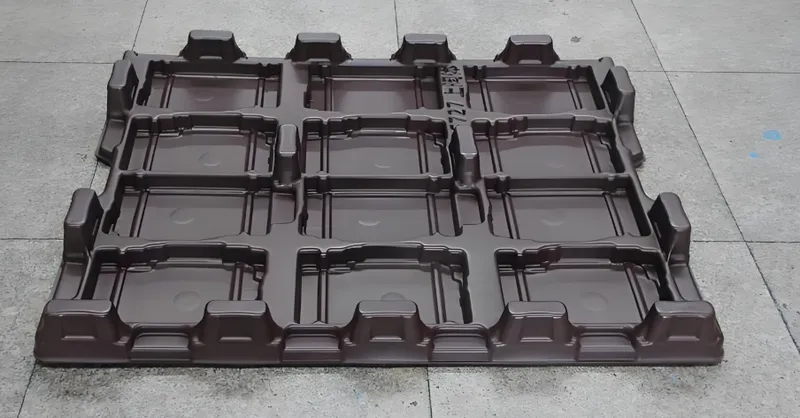
-
Smoothing: Sanding or polishing for refinement.
-
Coating: Spray or roller application for protection.
-
Texturing: Matting or embossing for effect.
-
Decorating: Printing or wrapping for branding.
Proper mold design is crucial for success.True
Draft angles, venting, and material choice directly affect forming quality.
Finishing follows a fixed sequence.False
The sequence depends on product requirements and industry standards.
What are the Key Factors in Selecting Surface Finishing Techniques?
Choosing the right finishing technique optimizes performance and cost-effectiveness.
Key factors include material type6, application needs, production volume, and cost, guiding the selection process.
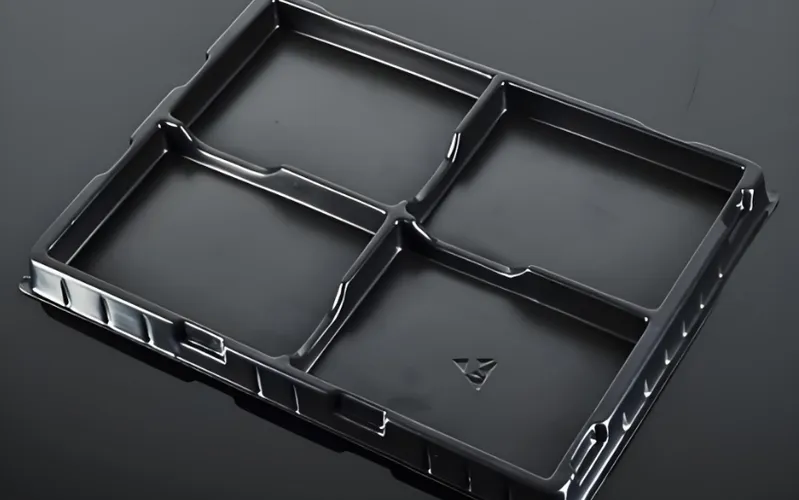
Material Type
Materials influence finishing compatibility:
-
ABS: Great for painting and plating.
-
PETG: Polishes well for transparency.
-
PVC: Requires specific adhesives for wrapping.
-
HIPS: Suitable for general finishing but less durable.
Application Requirements
End-use drives finishing choices:
-
Automotive: Durable coatings and textures.
-
Packaging: Clear finishes or graphics.
-
Medical: Smooth, cleanable surfaces.
-
Consumer Goods: Colorful or textured finishes.
Production Volume
Volume affects method selection:

-
Low-to-Medium: Manual or semi-automated finishing.
-
High: Automated processes like roller coating.
Cost Considerations
Balancing quality and budget:
-
Tooling Costs: Lower for vacuum forming7.
-
Per-Unit Costs: Higher for complex finishes.
Material selection is the top factor.False
Application needs and volume also play significant roles.
Automated finishing is always cheaper.False
Manual methods may be more economical for low volumes.
What are the Applications of Advanced Surface Finishing in Vacuum Formed Products?
Finishing enhances vacuum-formed products across industries.
Applications span automotive, packaging, medical, and consumer goods, each with tailored finishing needs.
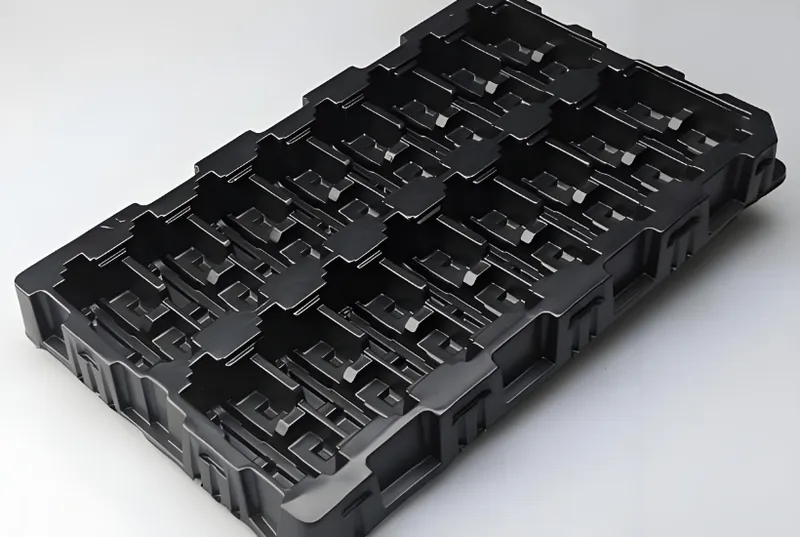
Automotive Industry
Dashboards and panels use painting and texturing for durability and grip, meeting safety and aesthetic standards.
Packaging Industry
Blister packs and clamshells feature clear finishes or printed graphics for visibility and branding.

Medical Industry
Device housings require smooth, antimicrobial finishes for hygiene and functionality.
Consumer Goods
Toys and casings use colorful textures or graphics for appeal and marketability.
Finishing is only for aesthetics.False
It also improves durability, grip, and hygiene.
Finishing reduces production costs.True
Optimized finishing minimizes waste and boosts efficiency.
What are the Differences Between Vacuum Forming and Injection Molding in Terms of Finishing?
Comparing these processes highlights their finishing needs.

Vacuum forming requires more secondary finishing8 than injection molding, which offers finer details directly from the mold.
| Aspect | Vacuum Forming | Injection Molding |
|---|---|---|
| Process | Less detailed parts | High-precision parts |
| Finishing | Multiple steps (trimming, coating) | Minimal (sanding, painting) |
| Cost | Lower tooling, higher finishing | Higher tooling, lower finishing |
| Volume | Low-to-medium | High |
Injection molding always yields better finishes.False
Advanced finishing can achieve high-quality results with vacuum forming.
Vacuum forming is ideal for prototyping.True
Lower costs and faster setup make it perfect for small runs.
Conclusion
Advanced surface finishing techniques unlock the full potential of vacuum-formed products, enhancing quality and functionality across industries. From trimming to decorating, these methods, paired with materials like ABS and PETG, cater to diverse needs. Explore vacuum forming to integrate these insights into your manufacturing process.
-
Explore this link to discover innovative surface finishing techniques that can significantly enhance the quality and appeal of your vacuum-formed products. ↩
-
Learn about advanced surface finishing methods that can improve durability and aesthetics, making your products stand out in the market. ↩
-
Explore this link to understand how surface finishing can significantly enhance the quality and performance of vacuum-formed products. ↩
-
Learn about trimming techniques to see how they improve precision and quality in vacuum-formed parts, especially in automotive and packaging. ↩
-
Discover various coating methods that enhance durability and aesthetics in vacuum-formed products, crucial for automotive and medical applications. ↩
-
Learn how different materials influence finishing choices, which is essential for optimizing product performance and cost-effectiveness. ↩
-
Explore this link to understand the vacuum forming process and its applications in various industries, enhancing your knowledge of manufacturing techniques. ↩
-
Understanding secondary finishing techniques can greatly enhance the quality of vacuum-formed products, making them more competitive in the market. ↩



